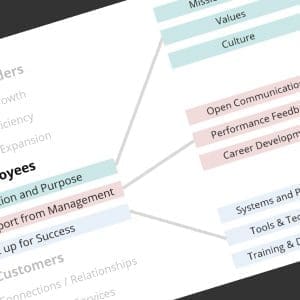Why aren't we moving faster? This story of a quick, simple back-of-envelope calculation that showed the large potential of a new product idea really got the team to think.
For the past few months I have been introducing the idea of information as a product or service (ie. the Internet of Things) to a number of our business units. It is a high-energy endeavor; there are plenty of product management and engineering folks thinking along these lines, and its great making the connections and filling in the blanks. Not all are aware of the term “Internet of Things”, but people can sense the opportunity and potential in their own markets. The trick, of course, is getting an organization to make the jump from “interesting idea” to fledgling product development. The phrase we’re a [thing] company, not a software company comes up in almost every conversation – I choose to see this as a refreshing signal of self-knowledge, and an opportunity to engage in a strategic conversation.
This great leap from “making and shipping Stuff” to “providing and supporting Data-Enabled Stuff” is specifically where the IT group can add a tremendous amount of value – if you can glibly bring design, development, communication, and process thinking to the conversation. Where do we start? What might this look like? and How much will this be worth? are all critical questions to ask. Going from unit to unit and asking these questions, we are catalyzing action by providing a conversation framework, a technology architecture, and a thoughtful sounding board.
Some patterns are developing, and a couple of exciting opportunities have already been identified. All are in various stages of planning and preparation before becoming actual products – and there are plenty more BUs on my list to talk to. Still, it’s a good time to pause a bit and catch up on my notes; a number of interesting observations can be made out of the product vision, customer empathy, and industry experience that is out there in the broader organization, pockets of innovative ideas and initiatives patiently waiting for that spark to start them running. I’m starting a long series of IoT Field Notes posts with a surprising conversation on how much revenue something like this could actually deliver((As you might expect, I am obfuscating the particulars – wouldn’t want to let the competition know what we are up to. Also, whenever I speak in $$ figures, I will alter things to be directionally accurate, to get a fair sense of the relative impact – these are representative figures only. But everything in these IoT Field Notes posts is based on real conversations, people, and products; we are making the Internet of Things real.)).
Size of the Prize
At one of the first BUs I spoke with – about $150M in total revenue – we had a fascinating conversation about the potential opportunity. The Engineering and Product Development teams were very open to brainstorm about how to use information as part of their product offering, but this was new to them – they hadn’t given it a lot of serious thought until now. Their core product – a relatively small (in size) component of a high performance system (think industrial pump, jet engine, or severe-duty valve) operating in a rather harsh environment. We spoke of it as the Canary in a Coal Mine use case – the component would have sensors to measure things like temperature, pressure, and other environmental factors, and capture data to drive predictive maintenance tasks (since a tear-down of said high-performance system is always expensive). The challenge, of course, is the harsh environment – how to put a sensor in there that could survive?
Sensing a pause in the conversation as we approached this apparently immovable obstacle, I switched the conversation over to Revenue – how much would something like this be worth? The team really knew their market – and quickly got into the depths of market impact. The play here would be to use the data to quantify product quality, guarantee performance – and reduce end-user maintenance time considerably. And someone said “… we’ll definitely gain share, no problem.”
My opening!, I thought. “So, how much share gain are we talking about?”

“Could double it”. Hmmm …
“What’s the current market size?” – $500M
“And our market share?” – 10%
“And we could double it to what?” – 20%
“And that is an annual figure?” – Yes
“So let me get this straight … if we solve this unsolvable problem, we could make an additional $50M per year in revenue?”
Silence.
You could see the whites of their eyes get a wee bit bigger, as the math worked out the numbers. Their numbers. Their opportunity …
… and the conversation picked up a bit after that.
A Dose of Reality
A few weeks later, and a bit of a reality check for this BU; simply put, there are too many other priorities right now in their fast growing business. Priorities already in the strategic plan, projects and products that frankly have a much clearer line of sight to success. Not a problem – part of the environment when introducing new ideas to an existing operational plan.
But that was just one company – there’s plenty more opportunity, we’ve only just begun, the cat is out of the bag …
8 December, 2014






Comments (3)
great start James!IoT is still in its early adopter stage with manufacturing, healthcare and insurance leading the way.As in your case, identifying the right use case is the key. In your future conversations, perhaps a risk free proof of concept might help evangelize in your favor?
Yes, part of our action plan for some early adopters is to help them spin up a proof-of-concept application. It helps folks to visualize the possibilities – both internal (potential project sponsors) and external (potential customers).
Bringing in a consultant with experience in this area, or getting involved with a strategic partner might be a good idea to jump start this. With IoT, there are a lot of potential partners that you might not expect. Outside of sensor, and embedded device developers – communications companies are also jumping on board as they realize they will greatly benefit if they can get devices on their networks.